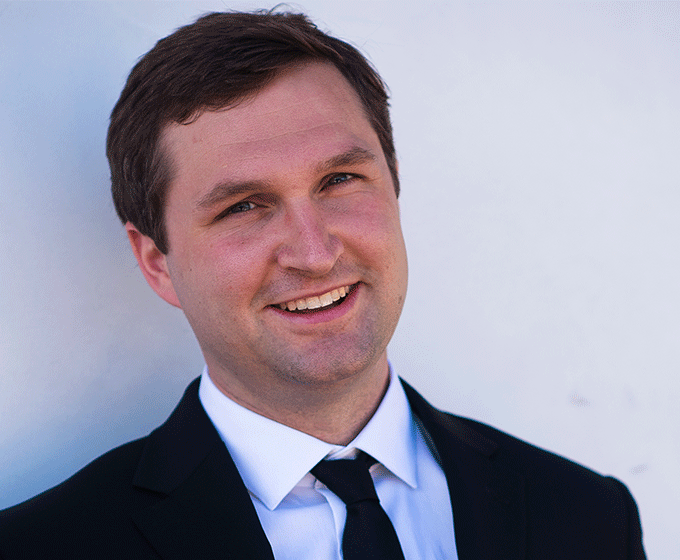
SEPTEMBER 8, 2021 — A UTSA researcher is part of a collaboration that has set a world record for innovation in quantum computing. The accomplishment comes from R. Tyler Sutherland, an assistant professor in the College of Sciences’ Department of Physics and Astronomy and the College of Engineering and Integrated Design’s Department of Electrical Engineering, who developed the theory behind the record-setting experiment.
Sutherland and his team set the world record for the most accurate entangling gate ever demonstrated without lasers.
According to Sutherland, an entangling gate takes two qubits (quantum bits) and creates an operation on the secondary qubit that is conditioned on the state of the first qubit.
“For example, if the state of qubit A is 0, an entangling gate doesn’t do anything to qubit B, but if the state of qubit A is 1, then the gate flips the state of qubit B from 0 to 1 or 1 to 0,” he said. “The name comes from the fact that this can generate a quantum mechanical property called ‘entanglement’ between the qubits.”
Sutherland adds that making the entangling gates in your quantum computer “laser-free” enables more cost-effective and easier to use quantum computers. He says the price of an integrated circuit that performs a laser-free gate is negligible compared to the tens of thousands of dollars it costs for a laser that does the same thing.
“Laser-free gate methods do not have the drawbacks of photon scattering, energy, cost and calibration that are typically associated with using lasers,” Sutherland explained. “This alternative gate method matches the accuracy of lasers by instead using microwaves, which are less expensive and easier to calibrate.”
This quantum computing accomplishment is detailed in a paper Sutherland co-authored titled, “High-fidelity laser-free universal control of trapped-ion qubits.” It was published in the scientific journal, Nature, on September 8.
Quantum computers have the potential to solve certain complex problems exponentially faster than classical supercomputers.
One of the most promising uses for quantum computers is to simulate quantum mechanical processes themselves, such as chemical reactions, which could exponentially reduce the experimental trial and error required to solve difficult problems. These computers are being explored in many industries including science, engineering, finance and logistics.
“Broadly speaking, the goal of my research is to increase human control over quantum mechanics,” Sutherland said. “Giving people power over a different part of nature hands them a new toolkit. What they will eventually build with it is uncertain.”
That uncertainty, says Sutherland, is what excites him most.
Sutherland’s research background includes quantum optics, which studies how quantum mechanical systems emit light. He earned his Ph.D. at Purdue University and went on to Lawrence Livermore National Laboratory for his postdoc, where he began working on experimental applications for quantum computers.
He became a tenure-track assistant professor at UTSA last August as part of the university’s Quantum Computation and Quantum Information Cluster Hiring Initiative.
UTSA Today is produced by University Communications and Marketing, the official news source of The University of Texas at San Antonio. Send your feedback to news@utsa.edu. Keep up-to-date on UTSA news by visiting UTSA Today. Connect with UTSA online at Facebook, Twitter, Youtube and Instagram.
Move-in Day is an exciting time for incoming students. Students living in Laurel Village move in on August 22. The UTSA Housing and Residence Life (HRL) team looks forward to welcoming you all and helping you settle into your room.
Laurel VillageThe College of Sciences welcomes our newest Roadrunners to UTSA at VIVA Science! This interactive event connects students with faculty, staff, student leaders, and peers while highlighting the opportunities available across the College.
Outdoor Learning Environment 2 (OLE), Flawn Building, Main CampusWe're excited to welcome the new class of UTSA College of Liberal and Fine Arts (COLFA) students to campus! Move In To COLFA is strongly recommended for new students in COLFA because it gives you the chance to learn about the Student Success Center, learn how to do college successfully and meet new friends.
Galleria (MH 2.01), McKinney Humanities Building, Main CampusBuild connections with your Alvarez College of Business peers and learn more about the Career Compass program! This opportunity will provide fun interactions, giveaways and a chance to meet your next friend!
Richard Liu Auditorium (BB 2.01.02,) Business Building, Main CampusCelebrate the end of summer and the start off a great fall semester with The Housing Block Party! This event will have live music, carnival-style treats, artists, games, and activities galore. Come and join us for a night of fun!
Multipurpose Room/Lawn, Guadalupe Hall, Main CampusBe part of an unforgettable night as SOSA takes the field for its first public performance of the season! Experience the power, pride, and pageantry of UTSA’s marching band. Learn beloved traditions, practice cheers, and feel what it means to be a Roadrunner.
Campus Rec FieldsAfter getting your student settled in their room, connect with other UTSA families at our Family Get Together. Attendees need to RSVP for the event.
Rock & Brews Restaurant - 5702 Landmark Pkwy, San Antonio, TX 78249The University of Texas at San Antonio is dedicated to the advancement of knowledge through research and discovery, teaching and learning, community engagement and public service. As an institution of access and excellence, UTSA embraces multicultural traditions and serves as a center for intellectual and creative resources as well as a catalyst for socioeconomic development and the commercialization of intellectual property - for Texas, the nation and the world.
To be a premier public research university, providing access to educational excellence and preparing citizen leaders for the global environment.
We encourage an environment of dialogue and discovery, where integrity, excellence, respect, collaboration and innovation are fostered.